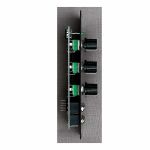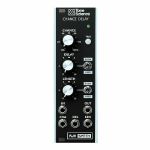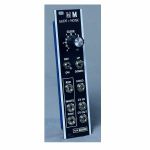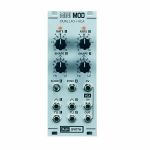100% Secure Shopping
Studio equipment
Our full range of studio equipment from all the leading equipment and software brands. Guaranteed fast delivery and low prices.
100% Secure Shopping
DJ equipment
Our full range of DJ equipment from all the leading equipment and software brands. Guaranteed fast delivery and low prices. Visit Juno DJ
Filter
Stock
Coming Soon
Equipment
Format
Brand
Featured
Price
Tags
Items 1 to 4 of 4 on page 1 of 1
AJH Synth/Tone Science Chance Delay Delay Effects Module (delay/effect/utility synth module)
Cat: 970428 Rel: 15 Sep 23
Chance generator and randomness with pulse delay and pulse conditioning module - 8HP.
Notes: The Tone Science Chance Delay is a unique concept in Eurorack modules as it combines chance and randomness, with pulse delay and pulse conditioning. It is a collaboration between electronic musician/composer Ian Boddy and AJH Synth.
It can perform as a Chance generator, but is also capable of pulse stretching for Trigger to Gate conversion, pulse shortening for Gate to Trigger conversion, Gate Delay, Sub Bass Generation and also "divide by n" clock division.
There is a wide range of control and all functions can be operated manually from the front panel or can be automated using external CV voltages. Chance can range between 0 to 100%. The Gate out can be delayed by anywhere between from 0.5mS to 30 Seconds, and the output Pulse length can also vary from 0.5mS to 30 Seconds.
The TRIG push button allows manual triggering of pulses, also determined by the Chance control, and a green LED shows the output pulse status.
Includes a handy "Gate pass through" mode; when the Length control is set to zero the incoming pulse or trigger will still be determined by the Chance and Delay controls, whilst the outgoing gate length will be the same as the incoming gate length.
Compact 8hp form factor and very low power consumption make this an excellent addition to any Eurorack system.
Key features:
Chance, Gate Delay time and Pulse Length can all be set manually or controlled using external CV voltages.
The 'TRIG' push button allows manual triggering, and Chance will be applied to any manual triggering too.
Fast processing allows operation into the lower audio range, so it can perform sub bass generation on drone type sounds. In this mode the Length pot (or an external Length CV) can be used to change the PWM of the output waveform.
After the initial trigger pulse has been acted on, further incoming pulses are ignored until the current cycle has finished. This useful feature allows it to perform "divide by n" division on gate pulses, so it can be used for clock division, and the delay function can be used to add a "swing" away from the rhythm.
Gate pass through mode - if the Length pot is set to zero, then the incoming gate length is preserved, so in this case the gate has Chance and Delay time applied to it, but the outgoing gate length is the same as the incoming gate length.
By setting Chance to 100% and Delay to zero (0.5mS) it can be used as a Gate to Trigger converter, or a Trigger to Gate converter, depending on the Pulse length set with the LENGTH control. We can also use an external Length CV to shorten or increase the length of the output pulse in real time.
Fast and slow ranges for both DELAY time and PULSE length - Fast range is 0.5mS to 2 Sec and Slow Range is 2 Sec to 30 Sec.
Green status LED shows when the output pulse is high.
Front panel controls
Chance Control and CHA Input
This sets the probability of an incoming trigger or gate being passed through to the Pulse Generator circuit. The chance can be set anywhere between 0% and 100%.
The CHA input allows an external control voltage (CV) to control chance remotely. In this mode the Chance control acts as an attenuator for the incoming CV. With the Chance control fully clockwise a CV of +5V will give 100% chance, and lower CV voltages reduce the Chance accordingly. For example, a +2.5V CV will give a 50% chance. The attenuator function is useful if we are using higher control voltages of for example 0 to +10V. If we set the Chance control to the 12 o'clock position it would then halve the incoming CV signal, so in this case +10V will give 100% chance and +5V will give a 50% chance. Negative CV voltages are ignored and will be treated in the same way as zero volts..
Delay Control and DEL Input
This sets the delay amount that is applied to the leading edge of the incoming Gate or trigger received at the IN jack (or a press of the Manual Trigger button), assuming that the "Chance" has been determined to be positive. With the Delay Time switch set to FAST the Delay range will be from 0.5mS to 2 Seconds. With the Delay Time switch set to SLOW the Delay range will be between 2 Seconds and 30 Seconds.
The DEL input allows an external CV voltage to control Delay Time remotely. In this mode the Delay control acts as an attenuator for the incoming CV. With the Delay control fully clockwise a CV of +5V will give the maximum Delay time of either 2 Seconds or 30 seconds depending on the position of the Fast / Slow switch. Lower CV voltages reduce the Delay Time accordingly, so if we apply a CV of zero volts then we will get the minimum Delay time. The attenuator works on any CV patched to the DEL input in the same manner as described for the Chance control.
Length Control and LEN Input
This sets the length, or rather pulse width of the output pulse. With the LENGTH Switch set to FAST the pulse length can be anywhere between 0.5 mS to 2 Seconds. With the LENGTH Switch set to SLOW the pulse length can be between 2 seconds and 30 Seconds.
The LEN input allows an external CV to control Delay Time remotely. In this mode the Length control acts as an attenuator for the incoming CV in the same manner as the Chance and Delay controls.
Setting the Length control to zero invokes "Gate pass through" mode - in this case the incoming gate length is preserved, so the incoming pulse or trigger will still be affected by the Chance and Delay controls, but the outgoing gate length will be the same as the incoming gate length. Turning the Length control slightly clockwise will then invoke the minimum pulse length around control position 1, and further clockwise rotation will increase the Pulse Length as expected. This behaviour also applies to external CV's patched to the LEN input, where a CV of 0V will enable Gate pass through mode.
Fast / Slow mode switches
These switches allow the selection of Fast or Slow mode for Delay time and pulse length, so these ranges can be selected independently for Delay and Length. Fast range is 0.5 mS to 2 Seconds, and Slow range is 2 Seconds to 30 Seconds.
TRIG Switch
The TRIG push button allows manual triggering, and Chance will also be applied to any manual triggering, so depending on the setting of the Chance control, pressing the button has a chance of not doing anything! Holding the button down keeps the incoming gate high for as long as the button is pressed, however this is only really relevant in "Gate pass through" mode - normally only the leading edge of the input pulse is used.
IN - input jack
Connect your input here - a gate, output from an LFO, or even waveforms from a VCO. Any negative component of the input voltage will be ignored, so unipolar or bipolar signals can be used.
OUT - output jack
This outputs the binary pulse (or stream of pulses) that are generated by the Chance Delay circuitry. The gate low level is 0V and gate high level is +6V. The green status LED shows if a pulse is currently being generated.
Module Width: 8hp
Module Depth: 26mm (Including power lead)
Current Usage: 25mA Positive, 6mA Negative
… Read moreIt can perform as a Chance generator, but is also capable of pulse stretching for Trigger to Gate conversion, pulse shortening for Gate to Trigger conversion, Gate Delay, Sub Bass Generation and also "divide by n" clock division.
There is a wide range of control and all functions can be operated manually from the front panel or can be automated using external CV voltages. Chance can range between 0 to 100%. The Gate out can be delayed by anywhere between from 0.5mS to 30 Seconds, and the output Pulse length can also vary from 0.5mS to 30 Seconds.
The TRIG push button allows manual triggering of pulses, also determined by the Chance control, and a green LED shows the output pulse status.
Includes a handy "Gate pass through" mode; when the Length control is set to zero the incoming pulse or trigger will still be determined by the Chance and Delay controls, whilst the outgoing gate length will be the same as the incoming gate length.
Compact 8hp form factor and very low power consumption make this an excellent addition to any Eurorack system.
Key features:
Chance, Gate Delay time and Pulse Length can all be set manually or controlled using external CV voltages.
The 'TRIG' push button allows manual triggering, and Chance will be applied to any manual triggering too.
Fast processing allows operation into the lower audio range, so it can perform sub bass generation on drone type sounds. In this mode the Length pot (or an external Length CV) can be used to change the PWM of the output waveform.
After the initial trigger pulse has been acted on, further incoming pulses are ignored until the current cycle has finished. This useful feature allows it to perform "divide by n" division on gate pulses, so it can be used for clock division, and the delay function can be used to add a "swing" away from the rhythm.
Gate pass through mode - if the Length pot is set to zero, then the incoming gate length is preserved, so in this case the gate has Chance and Delay time applied to it, but the outgoing gate length is the same as the incoming gate length.
By setting Chance to 100% and Delay to zero (0.5mS) it can be used as a Gate to Trigger converter, or a Trigger to Gate converter, depending on the Pulse length set with the LENGTH control. We can also use an external Length CV to shorten or increase the length of the output pulse in real time.
Fast and slow ranges for both DELAY time and PULSE length - Fast range is 0.5mS to 2 Sec and Slow Range is 2 Sec to 30 Sec.
Green status LED shows when the output pulse is high.
Front panel controls
Chance Control and CHA Input
This sets the probability of an incoming trigger or gate being passed through to the Pulse Generator circuit. The chance can be set anywhere between 0% and 100%.
The CHA input allows an external control voltage (CV) to control chance remotely. In this mode the Chance control acts as an attenuator for the incoming CV. With the Chance control fully clockwise a CV of +5V will give 100% chance, and lower CV voltages reduce the Chance accordingly. For example, a +2.5V CV will give a 50% chance. The attenuator function is useful if we are using higher control voltages of for example 0 to +10V. If we set the Chance control to the 12 o'clock position it would then halve the incoming CV signal, so in this case +10V will give 100% chance and +5V will give a 50% chance. Negative CV voltages are ignored and will be treated in the same way as zero volts..
Delay Control and DEL Input
This sets the delay amount that is applied to the leading edge of the incoming Gate or trigger received at the IN jack (or a press of the Manual Trigger button), assuming that the "Chance" has been determined to be positive. With the Delay Time switch set to FAST the Delay range will be from 0.5mS to 2 Seconds. With the Delay Time switch set to SLOW the Delay range will be between 2 Seconds and 30 Seconds.
The DEL input allows an external CV voltage to control Delay Time remotely. In this mode the Delay control acts as an attenuator for the incoming CV. With the Delay control fully clockwise a CV of +5V will give the maximum Delay time of either 2 Seconds or 30 seconds depending on the position of the Fast / Slow switch. Lower CV voltages reduce the Delay Time accordingly, so if we apply a CV of zero volts then we will get the minimum Delay time. The attenuator works on any CV patched to the DEL input in the same manner as described for the Chance control.
Length Control and LEN Input
This sets the length, or rather pulse width of the output pulse. With the LENGTH Switch set to FAST the pulse length can be anywhere between 0.5 mS to 2 Seconds. With the LENGTH Switch set to SLOW the pulse length can be between 2 seconds and 30 Seconds.
The LEN input allows an external CV to control Delay Time remotely. In this mode the Length control acts as an attenuator for the incoming CV in the same manner as the Chance and Delay controls.
Setting the Length control to zero invokes "Gate pass through" mode - in this case the incoming gate length is preserved, so the incoming pulse or trigger will still be affected by the Chance and Delay controls, but the outgoing gate length will be the same as the incoming gate length. Turning the Length control slightly clockwise will then invoke the minimum pulse length around control position 1, and further clockwise rotation will increase the Pulse Length as expected. This behaviour also applies to external CV's patched to the LEN input, where a CV of 0V will enable Gate pass through mode.
Fast / Slow mode switches
These switches allow the selection of Fast or Slow mode for Delay time and pulse length, so these ranges can be selected independently for Delay and Length. Fast range is 0.5 mS to 2 Seconds, and Slow range is 2 Seconds to 30 Seconds.
TRIG Switch
The TRIG push button allows manual triggering, and Chance will also be applied to any manual triggering, so depending on the setting of the Chance control, pressing the button has a chance of not doing anything! Holding the button down keeps the incoming gate high for as long as the button is pressed, however this is only really relevant in "Gate pass through" mode - normally only the leading edge of the input pulse is used.
IN - input jack
Connect your input here - a gate, output from an LFO, or even waveforms from a VCO. Any negative component of the input voltage will be ignored, so unipolar or bipolar signals can be used.
OUT - output jack
This outputs the binary pulse (or stream of pulses) that are generated by the Chance Delay circuitry. The gate low level is 0V and gate high level is +6V. The green status LED shows if a pulse is currently being generated.
Module Width: 8hp
Module Depth: 26mm (Including power lead)
Current Usage: 25mA Positive, 6mA Negative
1 in stock $186.68
Click for better price!
or call +44 20 7424 1960
quote 970428
quote 970428
AJH Synth MiniMod Glide + Noise MK2 Module (black) (noise/slew limiter synth module)
Cat: 708115 Rel: 22 Jan 19
MiniMod Glide + Noise, combining two Minimoog circuits in one module - 6HP
Notes: The original MiniMod Glide +Noise module was based exactly on the original Minimoog Model D circuitry, which was designed to be used with the built in Model D keyboard, and because of its vintage design its range was severely limited to 5 or 6 octaves, and it also responded to positive voltages only. Another limitation was that it would not return fully to zero when selecting long glide times, which restricted the range even more.
So we made the decision to re-design the MiniMod Glide + Noise using modern precision parts, and we have come up with an all new circuit which has exactly the same function, but with a hugely extended range. It has the same Glide slope characteristic (a slightly curved Linear Glide) as the Model D on which the MiniMod is based, however in response to many requests from customers we have adjusted the glide up and down speeds so that they are now very similar , which is much more useful in real world applications that the earlier MK1 version which (like the Model D) would glide up considerably faster than it would glide down.
The new Mk2 MiniMod Glide Noise module now has an impressive 14 octave range, and can respond to negative voltages down to -5V. This is a very useful feature, as our MiniMod VCO's will respond to negative control voltages and produce correspondingly low frequencies; so it is now possible to glide down quickly or slowly to crazy sub bass levels! The hold feature has been improved too, it covers the full audio range as well as DC control voltages, and works as a track and hold module with Eurorack signal levels.
A further enhancement is that the Mk2 module can now (using selectable jumpers) transmit or receive pitch CV to the Eurorack power bus; for example, the Glide CV Output can now be directed to the Bus in order to send CV's to (for example) three VCO's via the bus without the need for a passive multi and four patch cords!
The Noise section of the module is unchanged, except that we have slightly boosted the level of the Red Noise output to bring it more in line with Eurorack control voltage levels.
Lastly, it is much shallower - Mk1 Glide Noise had a depth of 54mm, and it was the only MiniMod module that was too deep to fit a skiff style case - and this prevented a full MiniMod system being installed into a shallow Eurorack case. The new MK2 version is only 28mm deep, so this allows both it and a full MiniMod system to be mounted into shallow skiff style Eurorack cases.
Dimensions: 6HP wide, 26mm Deep
Current draw: 36mA Positive, 38mA Negative
… Read moreSo we made the decision to re-design the MiniMod Glide + Noise using modern precision parts, and we have come up with an all new circuit which has exactly the same function, but with a hugely extended range. It has the same Glide slope characteristic (a slightly curved Linear Glide) as the Model D on which the MiniMod is based, however in response to many requests from customers we have adjusted the glide up and down speeds so that they are now very similar , which is much more useful in real world applications that the earlier MK1 version which (like the Model D) would glide up considerably faster than it would glide down.
The new Mk2 MiniMod Glide Noise module now has an impressive 14 octave range, and can respond to negative voltages down to -5V. This is a very useful feature, as our MiniMod VCO's will respond to negative control voltages and produce correspondingly low frequencies; so it is now possible to glide down quickly or slowly to crazy sub bass levels! The hold feature has been improved too, it covers the full audio range as well as DC control voltages, and works as a track and hold module with Eurorack signal levels.
A further enhancement is that the Mk2 module can now (using selectable jumpers) transmit or receive pitch CV to the Eurorack power bus; for example, the Glide CV Output can now be directed to the Bus in order to send CV's to (for example) three VCO's via the bus without the need for a passive multi and four patch cords!
The Noise section of the module is unchanged, except that we have slightly boosted the level of the Red Noise output to bring it more in line with Eurorack control voltage levels.
Lastly, it is much shallower - Mk1 Glide Noise had a depth of 54mm, and it was the only MiniMod module that was too deep to fit a skiff style case - and this prevented a full MiniMod system being installed into a shallow Eurorack case. The new MK2 version is only 28mm deep, so this allows both it and a full MiniMod system to be mounted into shallow skiff style Eurorack cases.
Dimensions: 6HP wide, 26mm Deep
Current draw: 36mA Positive, 38mA Negative
1 in stock $168.01
AJH Synth MiniMod Discrete Cascaded VCA Module (black) (VCA/dual/stereo synth module)
Cat: 625062 Rel: 22 Sep 16
Mini Mod Discrete Cascaded VCA Module
1 in stock $158.67
AJH Synth Mini Mod Dual LFO & VCA Module (silver) (B-STOCK) (synth module)
Cat: 934445 Rel: 22 Mar 17
B-STOCK: Box opened, product unused & in perfect condition
Notes: ***B-STOCK: Box opened, product unused & in perfect condition***
This has two LFOs, each with variable waveshape from Saw to Triangle to Ramp waveforms, or variable Pulse width on the Square wave output. LFO 1 has the addition of a low range and a Sync input. The nominal maximum frequency of the LFOs when in Triangle shape is 20Hz, but under certain combinations of settings they will go much higher, well into audio range.
Also included is a DC coupled VCA, the input of the VCA is normalised to the output of LFO 2, so a 0 to +5V input to the VCA CV input gives control of the LFO waveform amplitude. It can also be used as a stand alone VCA.
This module is very useful for controllers such as the Waldorf KB37 where the modulation wheel gives out 0 to +5V, this can be routed to the VCA CV module so the level of the modulation waveform can be easily controlled. This makes it very easy to add VCO vibrato or filter 'wah' with control of modulation amount from the modulation wheel or other controller.
… Read moreThis has two LFOs, each with variable waveshape from Saw to Triangle to Ramp waveforms, or variable Pulse width on the Square wave output. LFO 1 has the addition of a low range and a Sync input. The nominal maximum frequency of the LFOs when in Triangle shape is 20Hz, but under certain combinations of settings they will go much higher, well into audio range.
Also included is a DC coupled VCA, the input of the VCA is normalised to the output of LFO 2, so a 0 to +5V input to the VCA CV input gives control of the LFO waveform amplitude. It can also be used as a stand alone VCA.
This module is very useful for controllers such as the Waldorf KB37 where the modulation wheel gives out 0 to +5V, this can be routed to the VCA CV module so the level of the modulation waveform can be easily controlled. This makes it very easy to add VCO vibrato or filter 'wah' with control of modulation amount from the modulation wheel or other controller.
2 in stock $153.25
Items 1 to 4 of 4 on page 1 of 1








